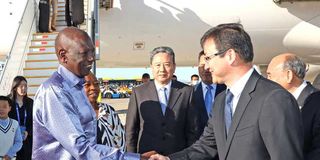Belt & Road can bring SDGs

President William Ruto arrives in China on October 15 for the third Belt and Road Forum.
Just two years after the rollout of China’s Belt and Road Initiative (BRI), the UN adopted the Sustainable Development Goals (SDGs). The 17 SDGs were primed to end poverty in all its forms, protect the planet and improve the quality of life.
But with just seven years left to fully implement them, UN Secretary-General António Guterres has warned that SGDs could remain a pipe dream, particularly in developing countries, which are wracked by climate change effects, economic slowdown and geopolitical divides.
Earlier this month, partners from 151 countries and 41 international organisations converged on Beijing to celebrate 10 years of BRI.
The delegates signed 458 outcome agreements in diverse areas—such as transportation, energy, agriculture, industrialisation and economic globalisation.
China’s President Xi Jinping announced new action points to aid building of high-quality BRI, including provision of 100,000 training opportunities on green development, by 2030. Commercial agreements worth $97.2 billion were also concluded.
With over 75 per cent of the UN family signed up, BRI has increased its appeal and influence to become a formidable catalyst for provision of regional public goods to foster sustainable and inclusive development.
In Africa, 52 of 54 countries, and the African Union, are implementing it. There’s much progress in its five pillars, giving impetus to SDGs.
Since 2012, China has pumped over $15 billion annually into modernisation of Africa’s infrastructure. Notable projects financed and built by China include Kenya’s Mombasa-Nairobi-Naivasha SGR; Ethiopia-Djibouti railway; Uganda’s Karuma hydropower; Nigeria’s Abuja-Masaka light rail; and a plethora of projects spanning the energy, mining, telecommunications, health and transport sectors. These have given impetus to Africa’s integration plan in the AU’s Agenda 2063.
Besides, BRI projects in Africa include over 130 hospitals and 170 schools, in addition to hundreds of African youth trained as doctors and teachers in China and visiting Chinese medical teams.
On climate adaptation, Beijing remains Africa’s largest partner in green energy transition and development thorough financing and technology. In 2009-2018, China upgraded solar capacity in Africa from 739MW to 5,500MW while wind energy installations jumped from a paltry 108MW to 6,100MW.
Africa has diversified its export markets with China its largest trade partner since 2009. Through the green lanes initiative, more African produce—such as Kenyan avocados, Rwanda’s chillies and Ethiopia’s coffee—are increasingly accessing the Chinese market.
Agriculture-based trade is a potent pathway out of poverty; hence the heightened desire to implement the African Continental Free Trade Area.
With China’s long-term and capital-intensive projects in the Global South through targeted technology transfer, developing countries can attract excess industrial capacity from China to foster manufacturing, value addition and other forms of industrialisation. That will create high-value sustainable jobs, products and services towards meeting the SGDs.
The challenge by BRI has triggered a rise in other international development cooperation platforms, whose net effect can only foster capacity of developing countries to realise the SDGs.
- Dr Cavince, PhD, is a scholar of international relations with a focus on China-Africa development cooperation. @Cavinceworld





